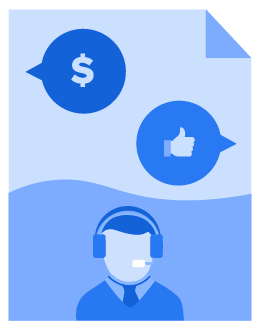Before you get started
Take a step back and think about your current business situation, relationships, and strategy before passing go.
Are you a new startup?
Having a strong team selling your software is the foundation of success. If you’ve just successfully launched and are ready to focus on growth, it’s the perfect opportunity to build a sales team that can help you reach your future goals.
If this sounds like you, we recently wrote a post about when to hire the first sales rep for your startup if you’d like some extra guidance.
Tip: If you know selling software to Fortune 500 companies is a big part of your future plans, invest in hiring people who already have valuable contacts in your field. Relationships with the right parties can be key, especially at large companies.
Big companies have the longest sales cycles, and that’s one reason why sales development representatives (SDRs) are an essential role in the earliest stage of sales. SDRs save valuable time sales reps would have to spend prospecting, multiply your quantity of prospects, and ultimately optimize your lead generation.
Keep reading for more info on how using a team of SDRs can be beneficial—if not essential—to your B2B software sales efforts.

Download the Best Cold Call Scripts for Software Sales
Our guide includes sales expert’s insights and best practices. Free for anyone who’s ready to create high-converting scripts.
Work your way up to a big company
Don’t try to jump straight to the 5th floor: Take the stairs. Before setting your sights on the largest companies, it’s valuable to have a strong portfolio of customers that are small or medium-sized businesses.
While selling to big companies can differ from selling to small companies at many points, you are ultimately doing the same thing: selling your software to help a business solve a business problem. Use what you know is proven to work with smaller sales and scale it up to fit future sales.
Get yourself and your software out there
You may see yourself as a business conducting a transaction with another business, but in reality, people are doing business with other people. Making meaningful and mutually beneficial business connections at every step in your career is not just valuable and constructive for you, but also for your contacts.
Take advantage of your prior relationships, form organic new ones, and get visibility at industry trade shows and company events: places you’re bound to make amazing contacts no matter what field your software serves.
Tip: If your software serves a particular industry, going to industry functions is an invaluable tool for meeting contacts, learning ways to improve your product, and becoming a regular, valued contributor to the industry sphere.
Not only can forming the right relationships with the right people be the key to selling in the future, but you’ll gain valuable insights into the ins and outs of industries and adapt your own product to be as valuable as possible.
Having any kind of contact within a large business, as well as whoever is influential to that business, is a prized resource.
Start targeting
Is your product, your team, and your marketing strategy ready to take on the big leagues? The last step is to get a targeted list of prospects together. Balance quality and quantity to make sure you have a robust but focused list of companies to target.
Tip: Build an Ideal Customer Profile (ICP) for your software. An ICP is a hypothetical organization that would benefit the most from your software, and represents the type of customer you most want to focus on acquiring. You can use your ICP to help target companies both large and small.
Selling to big companies will take concerted time and effort. Do your research, hone your process, and make sure all your targets are “worth the squeeze,” as both a profitable, high-value customer and a promising starting point in a relevant industry where your future customers will come from.
Once you’re thoroughly prepared and you have an A+ list of doors in your hallway, it’s time to start knocking.
A guide to getting in with a big company
Getting your foot in the door is the most important part of making the sale to any business, and crucial to selling your software to a big company. There are plenty of steps in developing the relationship that will result in a sale, but nailing your initial outreach and getting inside to the people who matter most is the key hurdle to overcome during that process.
While many aspects of the beginning of the sales process are out of your control (timing where a company is in terms of readiness to buy, other resources taking up the bulk of their budget that year, etc.), there are three key factors you can control to help ensure you get noticed and get in:
- Maximizing your outreach efforts
- Excellent proof of value
- Land, then expand

1. Maximizing your outreach efforts
Maximizing and optimizing your initial outreach will put you on the path to exactly where you need to be. As we already discussed, SDRs help accelerate your sales pipeline in a number of ways:- Ensure leads receive proper discovery, follow-up, and attention
- SDRs help maintain a clean and up-to-date database of target accounts
- Shorten sales cycles, especially for big deals with complex buying processes
- Keep account executives focused on prospects who are more likely to buy
Have SDRs look into:
- Pain points of targeted companies (and how your software will solve them)
- Personalization with specific outreach opportunities
- Who the ideal first point of contact is (read more on that below)
Tip: Do: Put in the effort to pinpoint specific business problems with your software as a potential solution. Don’t: Let SDRs use too much time on research—just enough to get started and maximize their valuable time.
There are many tips out there for cold calling best practices to get appointments. With big businesses (especially if you don’t have a clear internal contact with someone you already know), just a little touch of creativity and personalization during that initial outreach can go a long way in such a competitive environment.
SDRs can tailor their scripts and sprinkle in a few personalized details to really stand out during the cold calling process. Check out Best Cold Calling Scripts for Software Sales for a great guide.
Are you looking to set more appointments using the most well-trained, process-oriented SDRs who are wise to the ways of the cold-calling world? Talk to a specialist at EBQ to learn more.
2. Excellent proof of financial value
Having a strong, clear proof of your software’s value to your target company is fundamental for any sale. With a big business, tailoring this proof of value is especially crucial and presents you with a few additional factors to consider. If you’ve made it far enough with your software that you know you can land a sale to a “big fish,” you are likely offering a valuable product. This means a potential higher financial risk for your buyer. They don’t want to spend a large chunk of budget on something that:- Won’t solve a recognizable problem for their company
- Won’t result in a positive return on investment (ROI) for them
- Isn’t built out to the point that a large organization can utilize it
- Is it the president, CEO, or department head whose word is law?
- Is it a sole decision maker like the above—who also requires board approval?
- Is it someone who physically makes the choice, but depends heavily on opinions of or decisions made by team members?
Tip: Depending on your software and the type of clients you’re determined to work with, you may consider customizing and growing your own product to help suit that client’s situation. Market feedback, especially from big businesses and crucial clients, can be a stellar tool to take advantage of—just don’t go overboard on changes and complicate a simple product that works.
3. Land, then expand (into the rest of the company)
You’ve picked your target, done your research, and brainstormed your best pitches: it’s time to try and bring your ship in for landing.
The “land and expand” strategy is the most common opportunity for getting in with large organizations. You don’t have to sell your software to an entire company—you just have to land in the right faction and with the right contact.
Now is the time to take advantage of any existing business relationships you have within your target company. If you are going in cold, your SDRs can employ the previously discussed approaches and research to make sure their first point of contact is the right one.
Define a buyer persona: you know you want to sell your software to a big company, but you also need to know exactly who’s buying when you make the approach. A buyer persona helps you understand who your future buyers are, the best ways to reach them, and ultimately help convert prospects into real customers. Having a well-defined buyer persona can help you understand who your buyer is and accommodate them throughout the customer journey.
Dedicate some time to more research on your buyer persona, leverage this information to tailor the information you present, and help your sales team better predict future questions, roadblocks, and develop a rapport with the prospect as the sales process moves along.
Once you’ve made contact with the right person on their side, this person can be your biggest ally in helping you and your sales team move your software through the process. They can get their peers and superiors excited about your product and help handling internal hurdles that may arise in the future.
Developing and nurturing prospect relationships
Congratulations, you’ve overcome the largest hurdle in the sales process: sticking the landing.
Now it’s time for your star sales team to shine. After you’ve successfully set an appointment, the sales rep puts in most of the heavy research and high-touch effort. This is when you can build on all your initial research points about your target’s key buyer persona, sales cycle, decision-maker hierarchy, and more.
Sales team strength and consistency matters. As we discussed, the B2B sales cycle at big companies is a long one. You’re now “in it for the long haul” and can focus on building relationships, rapport, and moving your software through the cycle to win over the final decision maker.
Set yourself up for success with an experienced sales team that has the perfect balance of emotional intelligence and deal-closing technique.
Use your success to build more success.
Tip: Enterprise “big business” accounts require a lot of customer care to retain and keep happy. Keep this investment of your time and customer care resources in mind as your customer portfolio grows.
Now that you’ve closed that first enterprise sale, you can use this business as a resource to help boost your reputation and eventually sell software to more big companies.
Learn from your mistakes and successes, and you can continue to grow your portfolio of large companies who love and want to buy your software.


